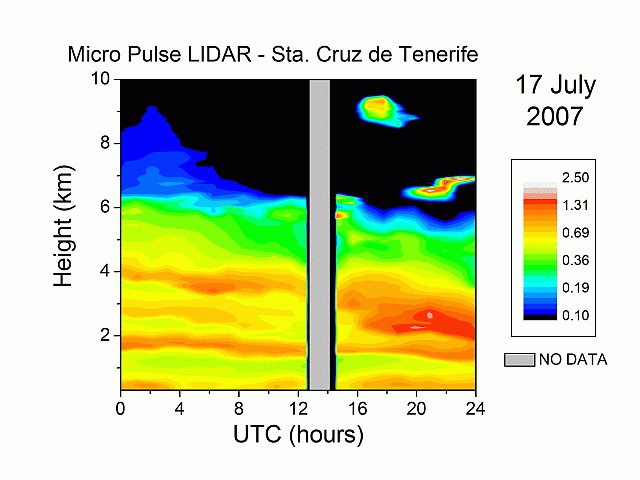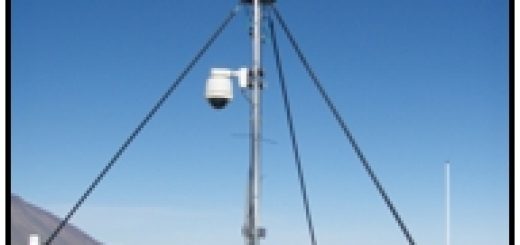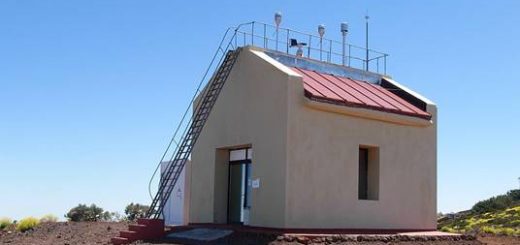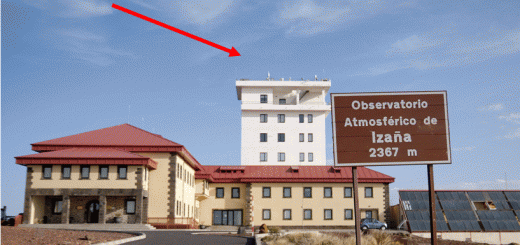Aerosol LIDAR research and monitoring program at Santa Cruz Atmospheric Observatory


Introduction
Air suspended matter (aerosols) plays an important role in the radiative balance of the atmosphere, influencing both solar and thermal radiations (IPCC, 2007). Evaluation of this aerosol-radiation interaction is crucial for climate forcing assessment, even at local scales. At present large uncertainties exist mainly caused by an incomplete characterization of the optical and microphysical properties of the aerosols.
An accurate knowledge of the aerosol vertical structure properties is required for climate forcing and for air quality studies, in addition to more technical needs such as a) UV radiation field interference affecting ozone measurements from satellite platforms; b) aerosol modelling validation; c) Validation of aerosols from satellites, d) particle-cloud interaction assessment, etc.
Elastic lidars provide quality aerosol height-resolved information from the boundary layer to the stratosphere at high vertical resolution. For this purpose, vertical distributions of aerosol extinction and backscattering properties are monitored at Santa Cruz Atmospheric Observatory in a continuous basis within the Micro Pulse Lidar NETwork (MPLNET).
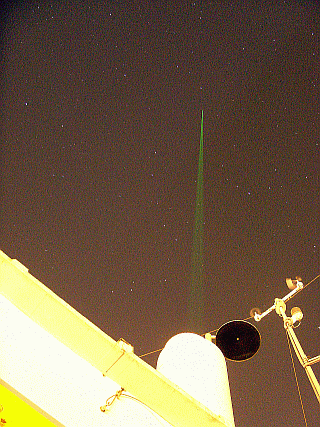
View of the green laser ray during night measurements at SCO
Measurement Programs
Height-resolved measurements of backscattering signal returned from atmospheric suspended particles are performed by a so-called ‘micropulse lidar’ system: Micro Pulse Lidar version 3 (MPL-3). The instrument is part of the NASA MPLNET worldwide aerosol lidar network (http://mplnet.gsfc.nasa.gov) and follows its measurement protocol. It’s operational in full-time continuous mode (24 hours a day / 365 days a year) except for summer solstice around noon time periods. MPL-3 measurements of backscattered signal are routinely performed in 1-minute integrated time and at 75 m vertical resolution.
The Izaña Atmospheric Research Center (AEMET) and the Spanish Institute for Aerospace Technology (Instituto Nacional de Tecnica Aeroespacial, INTA) co-manage the MPL routine observation management and started a long-term measurement program in 2005.
Research Activities
TROMPETA (TROpical Monitoring PhasE of The Atmosphere) project. It is devoted to study the potential ozone retrieval interference mechanism of nadir-looking UV-sattellite spectrometers due to absorbing aerosols (Gil et al., 2006).Intercomparison of LIDAR instrumentation within the frame of SPALINET, the recently created Spanish and Portuguese Aerosol LIdar NET work. In this context, MPL-3 took part in the La Laguna intercomparison campaign (24-28 June 2007) (Sicard et al., 2009).Saharan dust intrusion monitoring. MPL-3 observations provide a unique tool to investigate the temporal and spatial evolution of the Saharan dust intrusions frequently invading the Tenerife surroundings.
MPL-3 square-range corrected data for 17 July 2007.
Data inversion provides optical (backscattering and extinction) properties for dust in time and vertical distribution. Comparison with AERONET retrieved AOD is in good agreement.
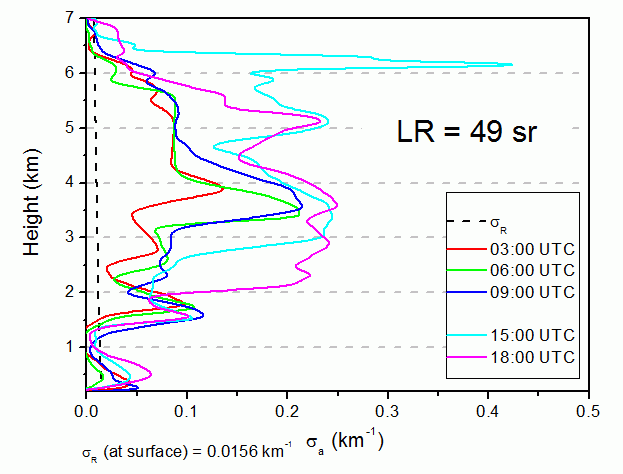
Retrieved height-resolved extinction coefficient for 17 July 2007.
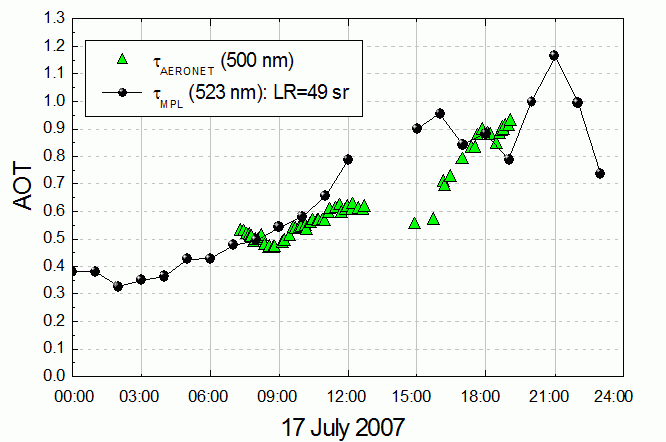
AOD comparison between MPL-3 and AERONET retrievals for 17 July 2007.
Cirrus cloud evolution monitoring. Cirrus optical depth can be estimated, and its relation with the tropopause height determined.

MPL-3 square-range corrected data for 12 February 2009:
Cirrus clouds are clearly distinguished at heights of 7-12 km.
Aerosol modeling and satellite validations:
- DREAM (Dust Regional Atmospheric Model), modeling performance requires the comparison with MPL-3 measurements for dust vertical structure determination.
- CALIPSO (Cloud-Aerosol Lidar and Infrared Pathfinder Satellite Observation) validation is involved with ground-based aerosol lidar networks, like EARLINET, MPLNET, …, devoted to establish an aerosol climatology.
Determination of the Saharan Air Layer (SAL).Differences in the retrieved properties for both Marine Boundary Layer (MBL) and Free Troposphere (FT) aerosols.Ozone-aerosol interactions on Saharan ourbreaks.
…
Dr. Carmen Córdoba-Jabonero (Lead, INTA)
Dr. Manuel Gil-Ojeda (INTA)
Dr. Emilio Cuevas (AEMET)
Mrs. Yballa Hernández (PhD student, AEMET)
Mr. Javier Andrey (PhD student, INTA)
Publications
Sicard, M., F. Molero, J.L. Guerrero-Rascado, R. Pedrós, F.J. Expósito, C. Córdoba-Jabonero, F. Rocadenbosch, A. Comerón, M. Pujadas, L. Alados-Arboledas, J.A. Martinez-Lozano, J.P. Díaz and M. Gil. Aerosol lidar intercomparison in the framework of SPALINET – the SPAnish LIdar NETwork: methodology and results. IEEE Trancsations on Geoscience and Remote Sensing, 2009 (accepted).
Meetings
Cordoba-Jabonero, C., Andrey, M. Gil and E. Cuevas. Vertical characterization of Saharan dust intrusions over Tenerife by ground-based lidar and airborne measurements. European Aerosol Conference 2009, Karlsruhe (Germany), 6-11 September, 2009.
Córdoba-Jabonero, C., M. Gil, S. Rodríguez and E. Cuevas. Micropulse Lidar monitoring of recent Saharan dust intrusions over Tenerife. Segunda Reunión Española de Ciencia y Tecnología de Aerosoles (RECTA 2008), Torremolinos, Málaga (Spain), 30 June – 1 July, 2008.
Sicard, M., A. Comerón, F. Molero, J.L. Guerrero-Rascado, R. Pedrós, F.J. Expósito, C. Córdoba-Jabonero, F. Rocadenbosch, M. Pujadas, L. Alados-Arboledas, J.A. Martinez-Lozano, J.P. Díaz, M. Gil, J.M. Bolarín, J.M. Moreno and A. Requena. SPALINET: the SPAnish Advanced LIdar NETtwork. Results from the first year: system intercomparison. 24th International Laser Radar Conference (ILRC24), Boulder CO (USA), 23 – 27 June, 2008.
Gil, M., J. F. Lopez-Herreros, S. Chueca, O. Serrano, S. Alonso, E. Cuevas, P. M., Romero, M. Navarro, J. Andrey, C. Córdoba-Jabonero, M. Yela, A. Redondas, S., Rodriguez, M. Schneider, I. Kramer, T. Blumenstock and C. Pérez. TROMPETA (TROpical Monitoring PhasE in The Atmosphere) Project: Aerosols-Radiation-Ozone interaction in the Subtropics. Proc. 5ª Asamblea Hispano-Portuguesa de Geodesia y Geofísica, 30/1-3/2, Sevilla, 2006.

